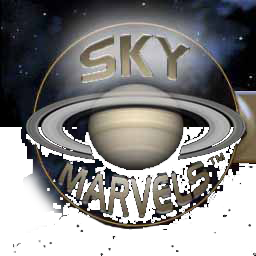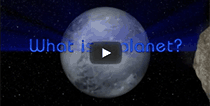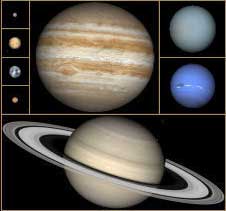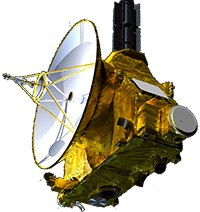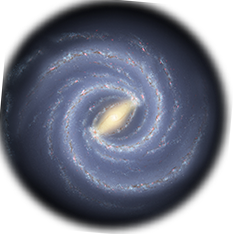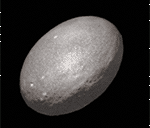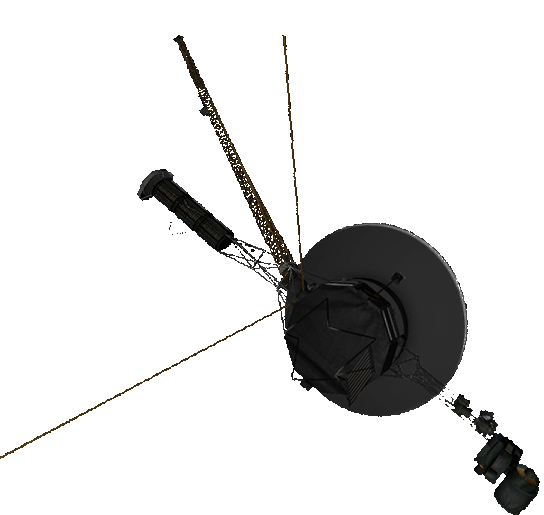
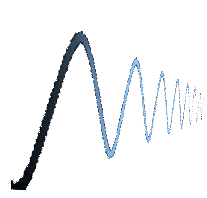



Immense and dynamic, our Solar System is made up of the Sun, 8 major planets, scores of moons and countless lesser worldlets! (1.6.x)
The major planets
and most major moons
orbit counter-clockwise
if viewed from "above" the Solar System! (1.6.x)
The Inner Planets orbit "relatively" near the Sun, yet the orbits of all the major planets are huge compared to the planets themselves! (1.6.x)
The distances between the planets' orbits are far from uniform—increasing outward from the Sun!


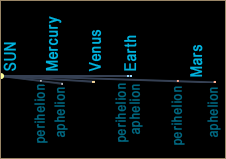
ENLARGED VIEW OF THE INNER PLANET ORBITS
FLATTER THAN A . . .
The Sun accounting for some 99.86% of the Solar System's mass, most of the rest is con- centrated in the planets. Yes, dwarf planets, comets, aster- oids, and other small bodies roam far above and below the Ecliptic. Still, most mass of the Solar System is confined to a disc-shaped region that we can say quite literally is "flatter than a pancake!"
INFERIOR AND SUPERIOR PLANETS
A planet's status as Inferior or Superior depends on the size of its orbit. The Inferior Planets, Mercury and Venus, are those with smaller orbits than Earth's; the Superior Planets are those with larger orbits. Likewise, Earth thus is often called the Reference Planet. The diagrams below illustrate the configurations (also called "alignments") that can occur with Inferior versus Superior Planets.
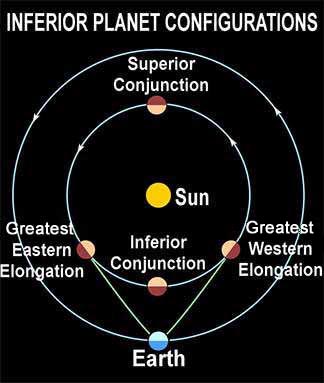
As you may gather from the above view, Inferior Planets exhibit phases to us like the Moon's. But there are basic differences. Although lunar phases appear to progress eastward across the Moon (relative to our sky, that is) the Inferior Planets' phases appear to progess westward or backward in comparison! So Inferior Planets "appear" New at Inferior Conjunction, in First Quarter at Greatest Western Elongation, Full at Superior Conjunction and
in Last Quarter at Greatest Eastern Elongation. There- fore, the intervals between the main phases of an Infe- rior Planet are much less uniform than those between our Moon's main phases. In addition, from our terrestrial perspective Inferior Planets never stray very far from the Sun and are invisible in its glare in substantial parts of their orbits.
In addition, two times each year each Inferior Planet's orbit can be seen "edge-on" from Earth!
Mercury's Venus's
So at rare times each planet can be seen passing directly across the Sun's disc!
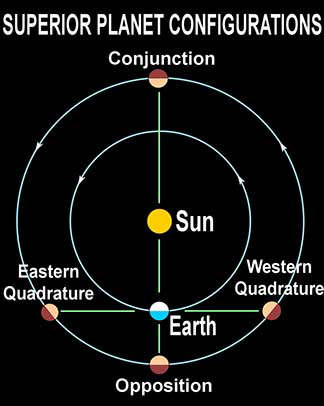
Moving beyond Earth's orbit, the Superior Planets travel completely around our home planet. Therefore, unlike an Inferior Planet, any Superior Planet is visible at midnight in part of its orbit. Moreover a Superior Planet can never exhibit less than a gibbous phase to us here on Earth. This means that whenever one is visible, its disc looks more than "half-illuminated" to us. Likewise, when it is at conjunction and opposition, it exhibits essentially a Full phase, and at quadrature it exhibits its minimum phase.
The awesome Planetary Configurations Simulator and Planetary Phases Sim- ulator let you interactively study how these phenomena relate to the Inferior and Suoerior Planets.
SOLAR SYSTEM ACTIVITIES
FIND YOUR WEIGHT AND AGE ON OTHER WORLDS
It's easy! Just use the slider tools slightly above and in the center column.
MAKE A SCROLL THAT
SHOWS THE SCALE OF THE SOLAR SYSTEM
From JPL, here is an easy to perform activity that reveals in a dramatic way the scale of the Solar System. This one will probably surprise many of you! You'll find that terms like "Inner Planets" and "Outer Planets" are very appropriate!
CREATE A LARGER "OUTDOOR" MODEL OF THE SOLAR SYSTEM!
The Kinesthetic Radial Mod- el of the Solar System is an excellent outdoor class activ- ity that will have students on their way to comprehending the nature, scale and make-up of our planetary system! You can even show current planet locations to make it a "working model"! Creating this "walk-thru" replica will engage everyone involved, so be sure you take lots of photos along the way! You may even consider planning a "Solar System Appreciation Picnic" among the planets! Great fun and loads of oppor- tunities for learning.
USE THE NASA/JPL ORRERY TO "VISIT" EACH PLANET
The NASA/JPL Orrery site makes it easy—and fun—to "visit" each planet and much more! Along the way you'll discover moons and space- craft too. It's a great way to introduce astronomy and space science to our future spacefarers and scientists!
FIND OUT WHICH SPACECRAFT THE DSN IS "CHATTING WITH" RIGHT NOW
It can be both intriguing and fun to learn which satellites the Deep Space Network (DSN) is "chatting with" at any time. After opening its page click on its radio dish symbols to find out. We've seen it communicating with eight different satellites at once on occasion! Will you find it "chatting with" more than that? If you do, record the time and date and let us know! It's awesome to know how well the DSN is keeping tabs on the Solar System!
CELES-TIPS
The following will help you enjoy this page's 1.6.x and 1.4.1 links that run events directly in CELESTIA. If you're new to the program, these tips will also help you learn to use it.
Are you unfamiliar with our 1.6.x and 1.4.1 links? For an explanation click here.
- If CELESTIA's clock (i.e. the program's date and time) is not visible at the top-right of its window, press the V key until you see it. This will also turn on information text in other corners to help you keep track of several as- pects of the event you're viewing. Keeping an eye on CELESTIA's clock at the top-right will help you appreciate how much time is passing in each view.
- Pressing the "un-shifted" L key and K key respectively will speed up and slow down CELESTIA's flow of time by a factor of 10 in version 1.6.x and 1.4.1.
- Pressing Shift+L and Shift+K respectively will speed up and slow down CELESTIA's flow of time by a factor of 2 in version 1.6.x only.
- Pressing the J key (either shifted or "un-shifted") will reverse CELESTIA's flow of time in version 1.6.x and 1.4.1.
You'll find more information about many of CELESTIA's controls on our Learning Center page.
![]()
Most of the
"classical asteroids",
like Ida,
orbit the Sun
in a vast doughnut-
shaped region called
the Asteroid Belt ![]() .
.
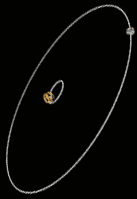
Pluto and Charon are
no longer considered to
represent the outer edge of the Solar System.
The Oort Cloud is
our Solar System's
great repository of
comet nuclei!
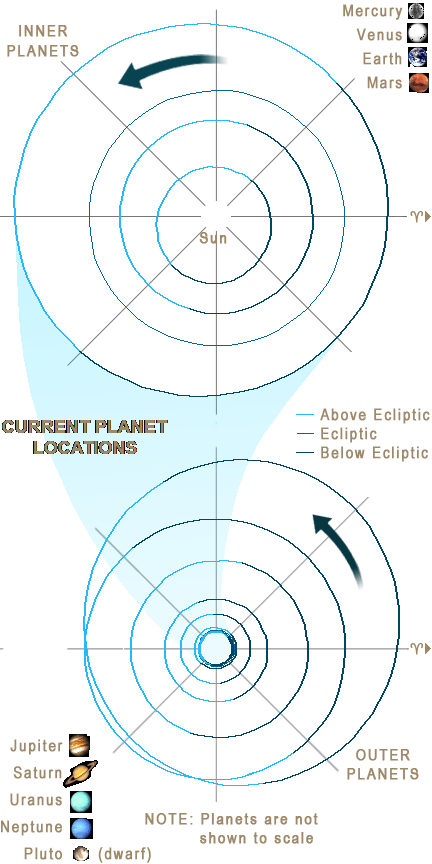
(to update, reload page) Courtesy: Fourmilab Switzerland
Current Planets Viewed from Earth
SOLAR SYSTEM
A CROSS SECTION OF THE SOLAR SYSTEM
Our Solar System is so vast and comprised of so many objects—some "relatively" near one another, yet most separated by great distances—that depicting large parts of it to scale is difficult. So you will have to look closely just above and to the left. Able to show only one side of the Solar System out to Neptune, this cut-away displays the 8 major planets' perihelia and aphelia distances (i.e. when they are closest to and farthest from the Sun), and their orbital inclinations relative to the Ecliptic—all to scale. Also indicated are regions where Smaller Worlds populate the Solar System: the Asteroid Belt, the expan- sive realm of the Centaurs, and the edge of the Kuiper Belt, which stretches from the orbit of Neptune to over 50 au from the Sun! (Note: when you hover above to reveal the "relative" sizes of the planets, their scale is hugely enlarged compared to that of the cross section!)
APPARENT SIZE OF THE SUN
FROM THE MAJOR PLANETS
Below and at left, slide the blue pointer left and right "or" click along the Astronomical Unit (au) scale (which also
shows light-time) to inspect the Sun's relative apparent size from from Mercury all the way out to Neptune! Most browsers (though not Safari) also permit you to use your keyboard Arrow Keys to "fine-tune" your slider position. Clearly the Sun, which simultaneously scorches Mercury and bakes Venus, is not nearly so prominent in the frigid skies of the Solar System's distant outer planets!
This page opens with the Sun (above) seen from Earth. The perihelia and aphelia of the major planets are shown in the adjacent cross section of the Solar System. Note that Venus's and Earth's orbits are so circluar that their extremes of distance are less than one pixel apart at this scale! At the Inner Planets in particular you will have to look closely—or zoom your browser—to pinpoint your distance! Mercury is especially seared by the Sun, and much more at its perihelion than its aphelion! Mars is close enough to the Sun that the Martian seasons are affected by the planet's orbital eccentricity! Uranus has the greatest difference between its nearest and farthest distances from the Sun! Yet the planet's orbit is so large that the Sun does not look much different from Uranus's perihelion to its aphelion! What other intriguing facts will you discover from planet to planet—and in between?
As you examine all this, you should also check out the Relative Intensity of Sunlight at the Planets. Since the human eye can adapt so well to varying light levels, you may be surprised by what "daylight looks like" as you venture further out in the Solar System.
CURRENT SOLAR SYSTEM VIEWS
Large Solar System Views: Inner Planets All Planets
Current Views from Earth: Sun Moon Planets
SOLAR SYSTEM IN INTERACTIVE 3-D
These tools all open showing current Solar System con- ditions. Their views can be rotated and zoomed in 3-D!
These open with the Vernal (March) Equinox ( ) in the "3 o'clock" direction:
) in the "3 o'clock" direction:
NASA/JPL Orrery The Sky-Live jsOrrery
This one opens with the Vernal (March) Equinox
( ) in the "9 o'clock" direction:
) in the "9 o'clock" direction:

YOUR WEIGHT ON OTHER WORLDS
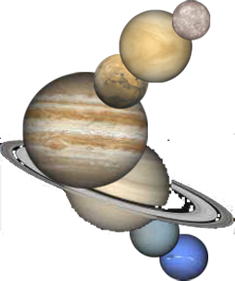
Notes:
1.) Set Weight on Earth to 1 (one) to find each world's
surface gravity compared to Earth's.
2.) Weight varies with latitude due to a world's rotation
and oblateness. Haumea, rotating once about every
four hours, provides an extreme example of this.
3.) Weight can also vary due to altitude, irregular shape
and non-uniform concentrations of mass.
YOUR AGE IN THE YEARS
OF OTHER WORLDS
This is how many times each world has
circled the Sun since you were born!
Note: set Age in Earth Years to 1 (one) to find how many of each world's years are in each Earth year.
CURRENT SUN, MOON AND MAJOR PLANET
VIEWS AND CONDITIONS FROM EARTH
Distances, Apparent Sizes, Phases, Moon Locations
Sun Moon Mercury Venus Mars
Jupiter Saturn Uranus Neptune
Locations in the Constellations
Sun Moon Mercury Venus Mars
Jupiter Saturn Uranus Neptune
Current Year's Elongations
Major Sky Objects 2021-2030
Greatest:
Mercury ![]() Venus
Venus ![]()


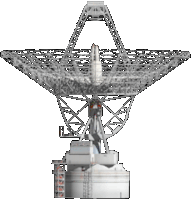 THE DSN: Our Link to Spacecraft
THE DSN: Our Link to Spacecraft
throughout the Solar System!
Who's "Chatting" Right Now?
DSN Antennas in 3-D:
70-meter ![]() 35-meter
35-meter ![]()
EXCELLENT NASA SOLAR SYSTEM PAGES
NASA'S "Solar System Exploration" Site
NASA'S "Life and Death of a Planetary System"
How Did the Solar System Come to Be?
Our Solar System's Location
in the Milky Way Galaxy
MAJOR COMPONENTS OF THE SOLAR SYSTEM
Dominant Body: the Sun (Sol, our nearest star)
Major Planets: 8
- Names: Mercury, Venus, Earth, Mars, Jupiter, Saturn,
- Uranus and Neptune
- Relative Sizes and Rotations of the Sun and Planets
- Axial Tilts of the Planets

- Where the Poles of the Sun & Planets Point

- NASA Planet Compare
- NASA Planetary Fact Sheets:
Ratio to Earth Values U.S. Units Metric - Planet Average Surface Temperatures

- Here's a link to another cool Chrome Experiment 3-D
visualization: PlanetMaker. - Solar System Temperature Chart
- Common Characteristics:
- All major planets orbit the Sun in the same direction,
i.e. eastward when viewed from above Solar system - All orbit in nearly the same plane
- All but Venus and Uranus spin in the same direction
- Planet Classifications:
- Inner Planets: Mercury, Venus, Earth & Mars
- Outer Planets: Jupiter, Saturn, Uranus & Neptune
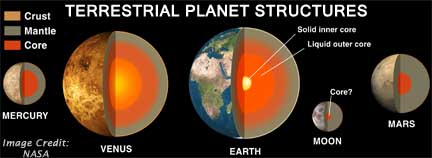
- Terrestrial (Earth-like) Planets:
- Mercury, Venus, Earth & Mars
- Hi-Res NASA Image of Structures
- Wikipedia Terrestrial Planets page
- Jovian (Jupiter-like) Planets (aka Gas Giants):
- Jupiter, Saturn, Uranus & Neptune
- Hi-Res NASA Image of Structures

- Magnetic Fields Compared to Earth's
- "Inferior" Planets (orbits smaller than Earth's, so
they exhibit full cycles of Phases): - Mercury & Venus
- "Reference" Planet: Earth
- "Superior" Planets (orbits larger than Earth's):
- Mars, Jupiter, Saturn, Uranus & Neptune
- Solar System Barycenter Gravity Simulator
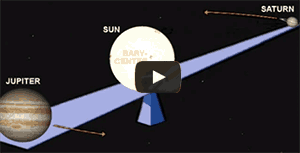
- Wikipedia's Barycenter page
- Planet Orbits: Inner Planets Inner & Outer Planets
- RASC's Planetary Orbits page Excellent!
- Because of the vast and disparate scales involved, for convenience Solar System maps generally must show the planets "out of scale" compared to each other as well as to their orbits. Actually, each plan- et's orbit is IMMENSE compared to the planet itself! Expressed in terms of its own diameter, here is each planet's approximate mean distance from the Sun.
- Mercury: 11,900
- Venus: 8,900
- Earth: 11,700
- Mars: 33,600
- Jupiter: 5,400
- Saturn: 11,900
- Uranus: 56,200
- Neptune: 90,800
- Said another way: this how many of each planet you'd have to "line up side-by-side" to reach from the Sun out to the planet's orbit! So even if mighty Jupiter was represented as a single pixel on your screen, showing its orbital distance in the same scale would place the Sun far off-screen!
- Moons:
- Mercury: 0
- Note: Mercury is too near the Sun to hold on to
moons for very long. The Sun's gravity "captures"
moons too far from Mercury, while the planet's grav-
ity draws moons too near it within its Roche Limit. - Venus: 0
- Note: while it is harder for planets closer to the Sun
to do so, Venus is theoretically at an adequate dis-
tance to hold on to moons. Why it has none is one
of the planet's great mysteries. - Earth: 1 view Moon page
- Mars: 2 view system
- Jupiter: 79 (more suspected) view major
- Saturn: 82 (more suspected) view major
- (29 waiting to be confirmed)
- Uranus: 27 (more suspected) view major
- Neptune: 14 (more suspected) view major
- Compare Major Moons
- Compare Solar System's Most Active Moons

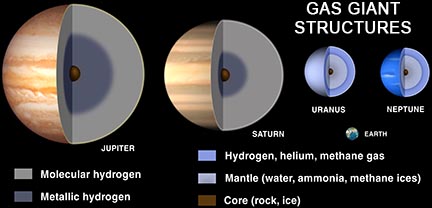

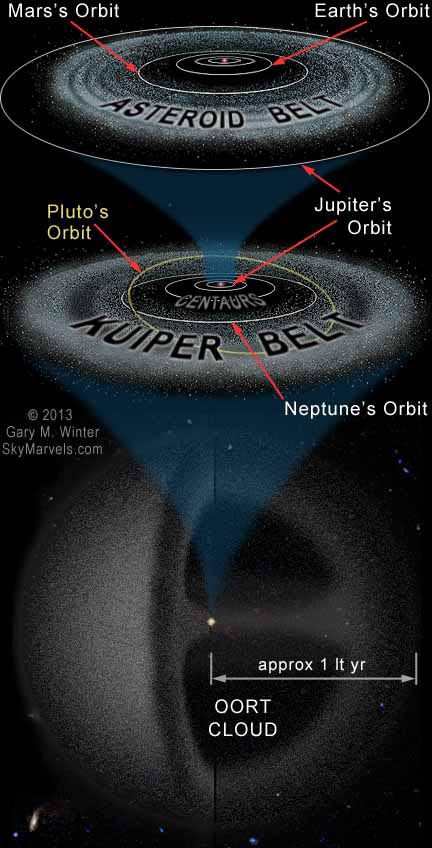
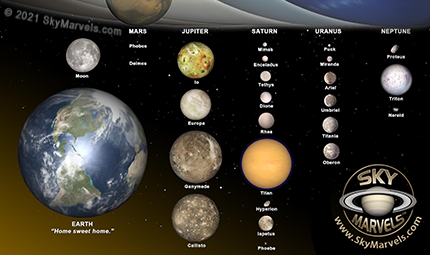
OTHER COMPONENTS AND THE
EXTENT OF THE SOLAR SYSTEM
The realm of the Sun is dizzingly more vast and complex than was once suspected. Stretching far beyond the orbit of Neptune, our Solar System is composed of much more than just our parent star and 8 major planets. In addition, millions of Smaller Worlds populate two major bands—the Asteroid and Kuiper Belts—between which is the region of the Centaurs! Far beyond the Kuiper Belt, billions (perhaps trillions) of worldlets may exist in that "great repository of comet nuclei," the Oort Cloud!
Dwarf Planets: 5 (hundreds suspected)
Names: (in order from the Sun)
Ceres, Pluto, Haumea, Makemake, and Eris
Asteroids: 500,000+ (millions suspected)
Names of Largest:
Pallas, Vesta, Hygiea, Interamnia
Types: C, S, M
Here's a link to a Chrome Experiment 3-D animation beautifully depicting the swarms of worldlets in the Asteroid Belt
Kuiper Belt Objects (KBO's): 1,000+ (millions susp.)
Names of Some of the Largest:
Quaoar, Makemake, Haumea, Sedna, Orcus, Varuna
Comets: 4,000+ (billions suspected)
Names of Some Notables:
Halley, Hale-Bopp, Swift-Tuttle, Shoemaker-Levy 9
WHAT IS A PLANET?
video credit: NASA
As a science progresses, new discoveries often require refinements in its systems of classification. Such was the case for astronomy and its classification of Pluto. This NASA video provides a good explanation of why this venerable wanderer at the edge of the "classical" Solar System was "demoted" to "dwarf planet" status.
This NASA page also provides an excellent discussion of the question.
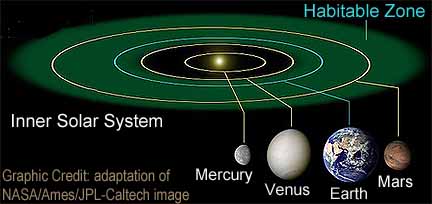
OUR SOLAR SYSTEM'S HABITABLE ZONE
Because life as we know it requires liquid water to exist, our Solar System's "habitable zone" is the region around the Sun where an Earth-sized planet could be expected to maintain liquid water on its surface. The habitable zone has also been popularly called the "Goldilocks zone", i.e. where it is neither too hot nor too cold for liquid water, but rather is "just right".
SOME OTHER COOL SOLAR SYSTEM PAGES
From NASA and JPL, here's a nice graphical synopsis of many firsts in humankind's exploration of the Solar System: Dare Mighty Things.
Trek through NASA's and JPL's own 3-D simulation of our Solar System. Exciting missions and adventures. (Requires Unity.) Eyes on the Solar System!
Here's a link to a nice NASA page: Chronology of Lunar and Planetary Exploration. Lots of good background info here!
Home Intro News Gallery Sky-Gifts Bonuses Tips
Learning Ctr Help Links Credits Legal Contact Us
© 2007-
by Gary M. Winter. All rights reserved.
Interested in political cartoons and humor?
Check out The HIPPLOMATS™.
SkyMarvels, Sky Marvels, SkyMarvels.com, CURRENT PLANET ORBITAL POSITIONS MAP. Current Planet Positions, Current Planet Locations, Planet Orbital Locations, See where the planets are in their orbits, Current Planetary Locations, Your Weight on Other Worlds. How Heavy Are You on Other Worlds? Your Weight on Other Planets. How Heavy Are You on Other Planets? Your Age on Other Worlds. How Heavy Are You on Other Worlds? Your Age on Other Planets. How Heavy Are You on Other Planets? celestia4all, celestiaforall, CELESTIA, astronomy, space, simulations, animations, downloadable astronomy posters, stars, planets, Inner Planets, Outer Planets, Inferior Planets, Superior Planets, moons, asteroids, comets, Oort Cloud, galaxy, galaxies, Milky Way, Andromeda, globular clusters, binaries, quasars, black holes, supermassive black holes, telescope, telescopes, planetarium, software, freestuff, satellites, add-ons, addons, scripts, eclipses, Solar Eclipses, Lunar Eclipses, Solar Eclipse Finder, Lunar Eclipse Finder, mutual eclipses, transits, occultations, Solar System, CELES-TOOLS, celeSTARrium, CELX, CELX programming, Freebies, Bonuses, multiple views, atronomical unit, light year, parsec, meteors, meteor showers, Perseids, Geminids, Leonids, barycenter, time, Time Zones, tides, alignments, conjunctions, oppositions, seasons, apogees, perigees, aphelion, perihelion, Earth, Luna, Mercury, Venus, Mars, Jupiter, Galilean Moons, Io, Europa, Ganymede, Callisto, Saturn, Titan, rings, Uranus, Neptune, Triton, E-MSpectrum, electromagnetic spectrum, astronaut, equinoxes, solstices, precession, rotation, spin, inclination, tilt, Ecliptic, orbits, ellipse, parabola, hyperbola
Donate safely with: PayPal
and receive one or more
Sky-Gifts. Your support is greatly appreciated!
NOTE: you do not need a PayPal account to donate.
SKY VIEWING
SOLAR SYSTEM
THE SUN
MERCURY
VENUS
EARTH
THE MOON
MARS
JUPITER
SATURN
URANUS
NEPTUNE
SMALLER WORLDS
STELLAR OBJECTS
EXOPLANETS
DEEP-SKY OBJECTS
SCALE OF THE COSMOS
———————
SKY-FUN / SKY-GAMES
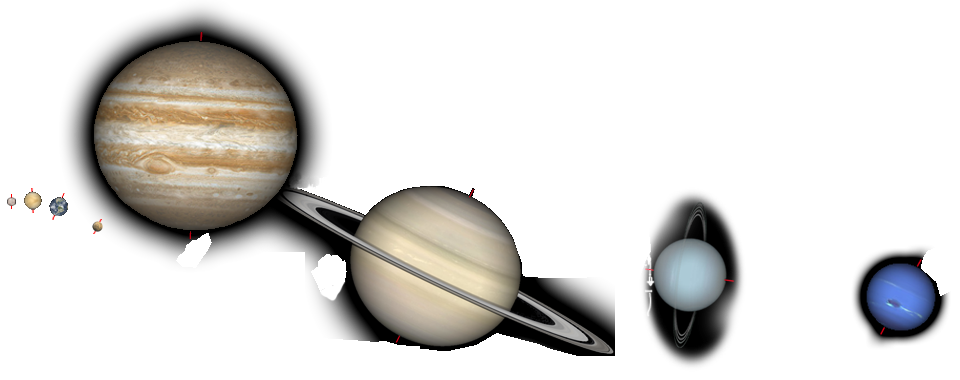
Hover over cross sec- tion above for "relative" planet sizes and tilts.
ELEMENTS OF THE MAJOR PLANET ORBITS
| Period (Earth Years) |
Orbital Inclin- ation |
Peri- helion (au) |
Aphe- lion (au) |
|
|---|---|---|---|---|
| Mer | 0.24 | 7.00° | 0.307 | 0.467 |
| Ven | 0.62 | 3.39° | 0.718 | 0.728 |
| Ear | 1.00 | 0.00° | 0.983 | 1.017 |
| Mar | 1.88 | 1.85° | 1.381 | 1.666 |
| Jup | 11.86 | 1.30° | 4.950 | 5.459 |
| Sat | 29.46 | 2.49° | 9.041 | 10.12 |
| Ura | 84.01 | 0.77° | 18.32 | 20.08 |
| Nep | 164.8 | 1.77° | 29.71 | 30.39 |
A little different from the cross section above, the one just below—meant mainly to show distance
—does not display each planet's orbital inclination.
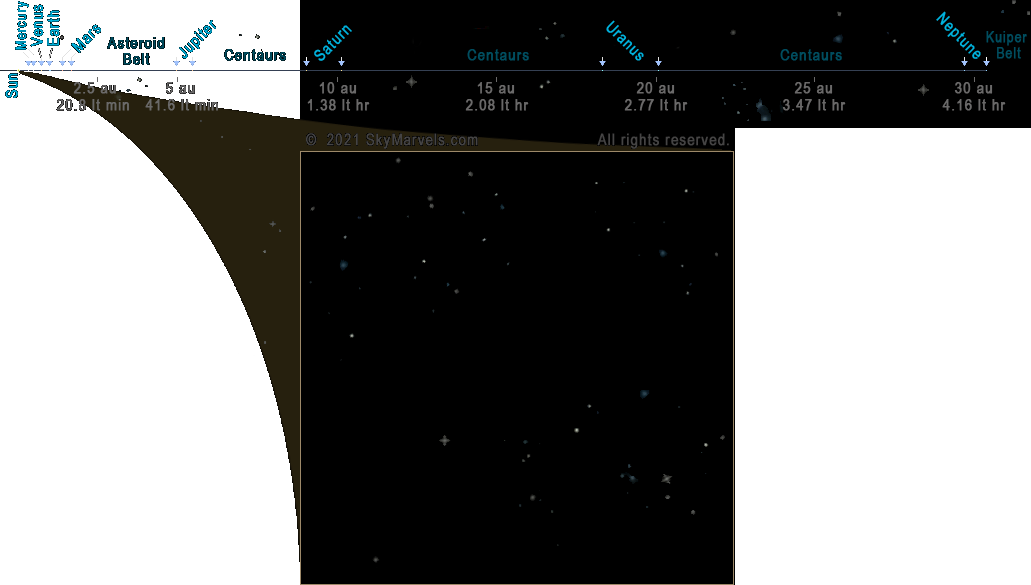
Seeing how big the Sun looks from all the planets gives us another way to appreciate the immense
scale of the Solar System!
 KEEP SAFE! It is never
KEEP SAFE! It is never
safe to look directly at the real Sun with the naked eye! Moreover, looking at it—even for an instant—through either a telescope, binoculars, camera or similar instrument without adequate safeguards can cause permanent blind- ness! NEVER DO IT! To learn how you may safely observe the Sun, consult your local planetarium or observatory.
THE VASTNESS OF
THE SOLAR SYSTEM
Most persons are surprised when they see Solar System distances displayed—as they are above—in their correct relative scales. The fact that the Inner Planets constitute such a small portion of the Solar System is a particular revelation to many.
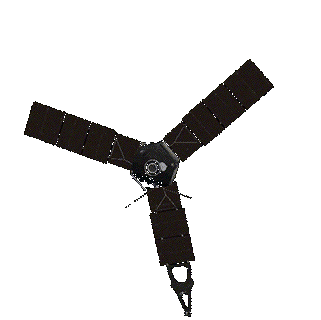
Realizing this makes it easier to appreciate the wondrous accomplishments of sending spacecraft to other planets, especially the Outer Planets —and beyond. Juno (above) is but one of several space- craft that have visited mighty planet Jupiter! New Horizons has flown past dwarf-planet Pluto, which is so far away that it could not be included in the cross sections above! And the Voyager spacecraft have long departed the realm of the major planets!
As you venture further down this page, and explore further out into deep space, you will realize that even distant Pluto —once considered the outer limit of the Solar System— can no longer be regarded as such! No, our Solar System is far more vast than that!
OUR SOLAR SYSTEM'S PLACE AND ORIENTA- TION IN OUR GALAXY
Our Solar Sytem's Place in Our Galaxy ![]()
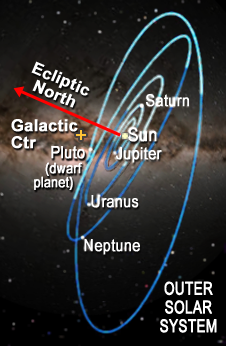
The Ecliptic, Earth's orbital plane, is often considered the plane of our Solar System. It is highly inclined to the plane of the Galaxy, which runs left to right in the diagram above.
SOLAR SYSTEM
FUN FACTS
Because stars migrate within, above and below the galactic plane, our Solar System may have occupied another spiral arm eons ago!
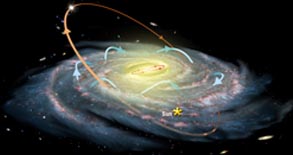
If you gained one pound on Earth, you will have gained 28 pounds on the Sun!
The planets do not actually orbit the Sun! They (and the Sun also) all orbit the Solar System's center of mass, a point which is called the Solar System Barycenter ![]() . The barycenter actually lies outside of the Sun for much of the time!
. The barycenter actually lies outside of the Sun for much of the time!
There is no reliable record of anyone on Earth living longer than the time it takes for Nep- tune to complete one orbit!
Of all the other planets, it is Venus which has an orbit closest in size to that of Earth. And yet, because of how the planets orbit the Sun, the major planet that spends more time closer to Earth than any other turns out to be Mercury! It's aver- age distance from Earth is quite a bit less than Venus's!
In fact, not only is Mercury the planet closest to the Sun, it is also the planet closest (on average) to each and every other major planet in our Solar System! ![]()
If all of the asteroids in the Asteroid Belt were gathered together into one body, it would be much smaller than Earth's Moon!
The Oort Cloud is thought to extend out to at least one quarter of the distance to the nearest star—perhaps much farther!
The dark portion of Jupiter's shadow, its umbra, has an average length that's greater than the radius of Mercury's orbit!
Close to 99% of the total mass of the Solar System is contained in the Sun!
SOLAR SYSTEM INTERACTIVES
QUICK ACCESS LIST
Note: some links are echoed elsewhere on this page and may include descriptive text.
Solar System in 3D:
NASA/JPL Orrery
The Sky-Live
jsOrrery
Solar System Scope
WWT Solar Sys. Explorer
NASA's Eyes on the Solar System This high-powered download is filled with loads of awesome features.
Planetary Motion Simulator widen its window after it loads.
Planetary Configurations Simulator
NASA's Planetary Data Sys- tems' Ring-Moon Systems Node has a whole suite of tools for making accurate charts and ephemerides.
NASA/JPL Orrery's Planet Comparison Mode
From NASA: Dare Mighty Things
SKYMARVELS™
CELESTIA ADD-ONS FEATURING OUR
SOLAR SYSTEM
SKYMARVELS™
POSTERS FEATURING OUR SOLAR SYSTEM
SKYMARVELS™
VIDEOS FEATURING
OUR SOLAR SYSTEM
Solar Eclipses:
Lunar Eclipses:
Moon's Occultation of Venus 2010 May 16
Moon's Occultation of Venus 2010 Sep 11
The Same Side of the Moon Always Faces Earth
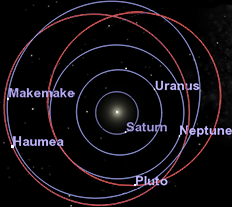
Dwarf Planet Haumea orbits far beyond Neptune and is currently much farther than Pluto!
